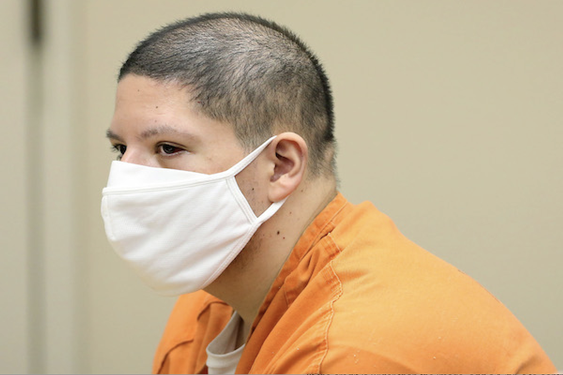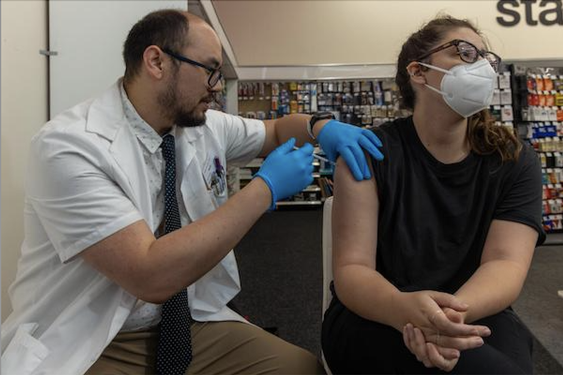Strict limitations on businesses and activities will remain in place throughout Southern California for the foreseeable future as COVID-19 patients continue to flood the region’s health-care system.
While not unexpected, Tuesday’s extension of the stay-at-home order for both Southern California and the San Joaquin Valley illustrates how the worst wave of the pandemic is hammering hospitals and threatening to exhaust the supply of intensive care beds throughout those regions, according to Dr. Mark Ghaly, California’s health and human services secretary.
There’s no timetable for when the restrictions could be relaxed. Ghaly said that they are in effect “for the time being” and that the decision to lift them hinges on ICU projections four weeks into the future.
And at this point, “we essentially are projecting that the ICU capacity is not improving in Southern California and the San Joaquin Valley, and that demand will continue to exceed capacity,” he said during a briefing Tuesday.
The dire and daunting task facing health care officials in both regions further underscores the state’s precarious pandemic position.
California on Monday again recorded its highest number of new coronavirus infections in a single day, with 66,811. Though that tally included a backlog from the long Christmas weekend, during which many counties did not issue reports, officials have said they expect that in the coming weeks there will be another surge in new infections stemming from gatherings and travel over the winter holidays.
Any significant spikes in coronavirus cases, experts warn, will invariably trigger a corresponding increase in the number of people needing to be hospitalized two to three weeks later. Hospitals statewide are already caring for more than 20,000 coronavirus-positive patients, the greatest number since the pandemic began.
“Frankly, many of the hospital leaders that I’ve talked to in Southern California are bracing for exactly that: a significant surge, a significant need to not only deal with what we’ve seen up until now, but an even more extreme condition in the middle and second part of January,” Ghaly said.
The state-defined Southern California and San Joaquin Valley regions have been under the latest stay-at-home order since Dec. 6.
Those regions cover a combined 23 counties that are home to the bulk of California’s population: Imperial, Inyo, Los Angeles, Mono, Orange, Riverside, San Bernardino, San Diego, San Luis Obispo, Santa Barbara, Ventura, Calaveras, Fresno, Kern, Kings, Madera, Mariposa, Merced, San Benito, San Joaquin, Stanislaus, Tulare and Tuolumne.
Officials have said the most recent round of restrictions — which include reduced capacity at retail stores; the closure of some businesses, including hair salons, nail salons, card rooms, museums, zoos and aquariums; and a prohibition on most gatherings, hotel stays for tourism and outdoor restaurant dining — are aimed at armoring hospitals against a torrent of COVID-19 patients.
The orders are put into place when a region’s intensive care unit bed availability falls below 15%, as has now happened in four of the state’s five defined regions: Southern California, San Joaquin Valley, the Bay Area and Greater Sacramento.
Only rural Northern California is currently not subject to the additional rules.
Once implemented, the restrictions have a mandatory three-week lifespan. They can be lifted after that, depending on a region’s expected hospital conditions in the near future.
The state’s assessment is based on four factors: ICU capacity, the rate of ICU admission, the seven-day average coronavirus case rate and the transmission rate.
Projections are made on a daily basis. If a region’s projected ICU availability reaches or exceeds 15%, it is released from the stay-at-home order. If not, the order remains in place.
However, that’s “not to say that it is there again for at least another three weeks,” Ghaly said of the extensions. “It could be shorter than that, depending on how these four factors come together on a day-over-day basis.”
Southern California and the San Joaquin Valley hit their initial three-week minimum Monday. But both regions have languished at 0% availability in their ICUs for more than a week.
Despite the startling percentage, that doesn’t mean there are no ICU beds; the state uses a weighted formula to ensure some remain open for patients who don’t have COVID-19.
“Whether or not we can eventually increase our ICU capacity to an adequate level is up to the behaviors of Los Angeles County residents — and the residents of all Southern California,” Los Angeles County Supervisor Hilda Solis said Tuesday in a statement. “COVID-19 cases are not limited to the borders of one county.”
However, even as hospitals stagger from COVID-19 overload and brace for more cases, a small ray of hope dawned Monday, indicating the stay-at-home order is starting to have an effect.
Looked at more broadly, the average daily number of cases reported over a weeklong period has fallen slightly from its peak, which reached about 45,000 a day for the seven-day period ending Dec. 22. By Monday night, the average daily number of new coronavirus cases was about 38,000.
The improvement is nothing to be overly cheerful about, though. Monday’s daily average is still worse than the comparable figure from two weeks ago. It will likely be some weeks before this flattening of new coronavirus cases results in a slight easing of new hospitalizations — a small reprieve ahead of what officials and experts expect will be another surge in new infections stemming from gatherings and travel over the winter holidays.
California’s hospitals are in crisis already. Statewide, 20,390 coronavirus-positive patients were hospitalized as of Monday, and 4,308 of them were in the ICU. Both those figures are highs and represent increases of 43% and 40%, respectively, from two weeks ago.
In L.A. County, hospitals are so overcrowded that some have had to convert conference rooms and gift shops into patient care areas. Others report such high demand for oxygen by COVID-19 patients that they’re having trouble maintaining air pressure in the pipes or experiencing shortages in supply.
Ghaly compared the situation facing hospitals to a rubber band. It can be stretched, but eventually there’s a breaking point.
“If you stretch far enough, certainly the ability to address all of a patient’s needs, to address the demands of new patients, becomes harder,” he said. “And certainly care can — and is — suffering because of the level of overwhelm some of these facilities have taken on.”
Ghaly said the plateau in average new daily coronavirus cases could offer a slight respite. However, officials have said they fully expect that hospitals will get hit by a mid-January wave of patients who were infected at Christmas and New Year’s gatherings, underscoring the importance of even a small dip in infections now.
“We’re pleased to see a little bit of a plateau,” he said. Without this flattening, “the impact that we anticipate coming from Christmas [and] New Year’s would be even worse.”
That’s all the more reason to show that many new coronavirus infections, hospitalizations and deaths can easily be prevented if people stay home and forgo gatherings outside their household for New Year’s, he added.
“Much of what we’re dealing with is avoidable,” he said. “Much of what we are seeing can be stopped, if we collectively make decisions to stop it.”
Along with staying home as much as possible for the time being, health officials say it’s essential that Californians continue to wear masks in public, regularly wash their hands, maintain physical distancing and avoid mixing with other households.
The average daily number of new coronavirus cases has also begun to flatten in L.A. County, generally hovering around 14,000 a day over the last 12 days.
County officials warn, however, that for hospitals to become safer, the caseload needs to level off at a significantly lower point.
A tally of 14,000 to 15,000 cases a day “is way too high for us to take any solace in,” L.A. County Public Health Director Barbara Ferrer said last week. “We’d have to level off at a much lower rate for us to protect our hospitals.”
On Monday, Ferrer said it was clear from what happened after Thanksgiving that “mingling with people outside of your immediate household is one of the leading causes for the current surge.”
“All it takes is one unfortunate encounter with an individual with COVID-19 for you to become infected and, sadly, for you to go on and infect many others,” Ferrer said. She urged that people who traveled for Christmas or other winter holidays to quarantine themselves for at least 10 days to see if they develop signs of illness.
The number of people hospitalized with COVID-19 in California remains at a high. Sunday was the 30th consecutive day that the state’s COVID-19 hospitalizations hit a new high, at 19,766, nearly eight times the number on Nov. 1.
The number of people in the state’s ICUs with COVID-19 is also at a high — 4,228 as of Sunday, nearly six times more than on Nov. 1.
Across California over the last week, an average of 231 people died every day from COVID-19. California is on track this week to mark its 25,000th COVID-19 death. As of Monday night, 24,545 deaths had been tallied statewide.
(c)2020 the Los Angeles Times
Visit the Los Angeles Times at www.latimes.com
Distributed by Tribune Content Agency, LLC.




